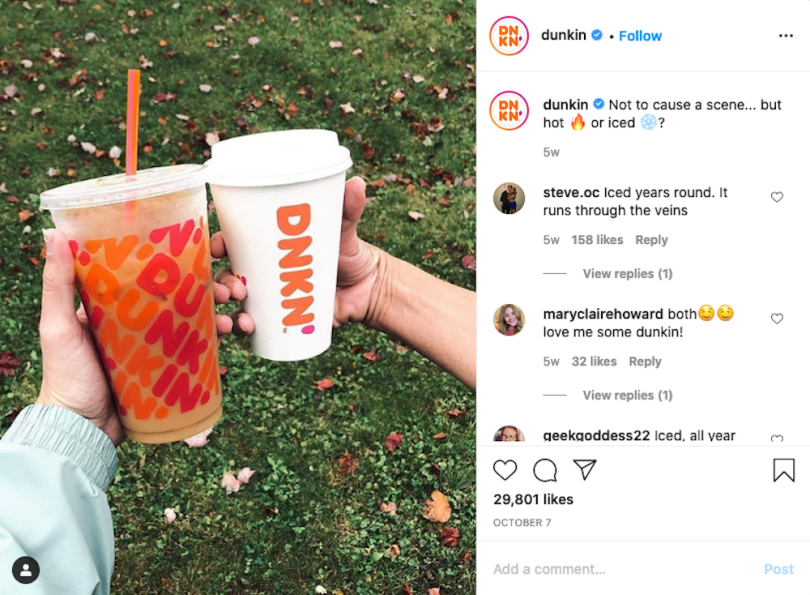On National Coffee Day, a woman posted an image of Dunkin’ coffee cups clinking in celebration to her some 800 Instagram followers. Within minutes, the official Dunkin’ account slid into the photo’s comments section and made a request.
“We’d like to potentially share this on our social channels!” Dunkin’s comment read. “If that sounds good, please reply with #yesdd.”
She did, and Dunkin’ — in line with the terms and conditions it linked to in its comment — reposted the image on its Instagram account.
It’s a common strategy. Brands face constant pressure to produce enough creative assets to capture the fleeting attention of visually oriented consumers, and harvesting user-generated content on social media allows them to keep up.

UGC Fuels Content-Starved Brands
Brands are always in need of more content. There is no shortage of landing pages, social feeds, digital ads and out-of-home signage for brands to adorn with photos, videos, testimonials and taglines touting their products.
Additionally, Facebook says that the fastest-growing advertisers on its platform produce 11 times more creative assets than their peers.
Thanks to social media and the ubiquity of camera phones, brands have unprecedented access to user-generated content they can repurpose for campaigns. Search for people posting about Dunkin’ on Instagram or TikTok, there’s plenty of UGC to choose from.
“And the good news is content creators are just getting better and better,” Lexy Wright, director of business development at Pixlee, a user-generated content and influencer marketing platform, told Built In.
“Content creators are just getting better and better.”
Wright has noticed more brands warming up to the idea of using UGC in their campaigns. That’s partly due to the rising quality of the content, given how many people have state-of-the-art cameras built into their phones and lighting kits on hand. But it’s also because UGC is resonating with consumers.
“Over the past few years, that hesitation has definitely dwindled. And I think it’s largely attributed to the media that the customers are expecting. They’re craving something that’s authentic, relatable. User-generated content is what people want to see these days,” Wright said.
And it works. Just ask people who tried to find Ocean Spray on grocery store shelves the week after the Doggface TikTok video went viral.
Using UGC comes with plenty of advantages, including savings, Wright said. Instead of hiring creative directors, writers and photographers — which can be expensive and time-consuming — brands look to UGC as a way to outsource their work to regular people who post positive content about the brand, unprompted and (typically) unpaid.
The pandemic and remote work has only accelerated this trend. Coordinating professional photo shoots has been logistically challenging, so brands are leaning on their employees and fans to do the heavy lifting and create content for them.
That said, the strategy comes with challenges.
‘One of the Biggest Pain Points Is Finding the Good’
When you post something to social media captioned with a brand’s hashtag, where does it go? Typically, to an overwhelmed social media manager.
An established consumer brand may have no problem finding images of people happily using their products. According to a report by Cohley and Digiday, of the some 300 brands and agencies surveyed in the summer of 2020, only 27 percent of respondents said there wasn’t enough user-generated content available.
But 79 percent said they struggled to find high-quality user-generated content.
“In other words, the problem isn’t scarcity, it’s discoverability,” the report said.
Many brands find that only a fraction of the available UGC strikes the right balance between authenticity and alignment with their brand identity, Wright said.
“One of the biggest pain points is finding the good,” she said. “It can’t just be anybody’s photo.”
“One of the biggest pain points is finding the good. It can’t just be anybody’s photo.”
The process of digging through UGC manually is not streamlined and scalable enough to have an individual or small team find the right images, get permissions, and repost them with any sort of efficiency, Wright said.
“These brands don’t really know how to find [the right UGC], how to engage with it, and how to publish it,” she added.
A number of software companies have emerged in recent years promising to give brands a simplified way to strain out unusable, off-brand UGC and find what can be collected for campaigns. These companies include Pixlee, as well as Stackla, Tint, Yotpo, Olapic and many others.
Enter AI-Assisted Curation
Advanced filter capabilities are central to making UGC platforms work.
In the Cohley and Digiday report, 59 percent of survey respondents said that AI tools assist their marketing teams in campaign content targeting. Some of these platforms implement pattern-matching algorithms to identify the images most likely to perform well with a specific demographic, which compresses the content-selection process, the report said.
Pixlee, for example, plugs into the APIs of several social media networks, pulls the data into its system, and runs it through AI models and computer vision searches before categorizing and cataloguing all the content. From there, brands can use filters to find specific content using keywords, hashtags and user handles. And it comes with an analytics dashboard so brands can see what content resonates with audiences the most.
Automating the tedious process of choosing photos gives marketers “a lot of time back,” Wright said. “It helps them scale themselves out.”
“We’ve developed tools to make that as easy as possible,” she added. “On our mobile app, we joke it’s like a Tinder, where you can swipe to approve and deny. [It’s] relevant for maybe, like, live events, where someone is on the fly watching photos come in. And in that moment they can maintain that brand control, but it can seem instantaneous.”
“They’re craving something that’s authentic, relatable. User-generated content is what people want to see these days.”
For now, platforms rely on a human making the final calls. But is it possible for brands to fully automate UGC collection and resharing?
It’s theoretically possible, Pixlee’s product manager, Kyle Bennett, told Built In.
“If you have pre-existing relationships with influencers you work with, you can set those flags in our platform to auto-approve and auto-permission, and if you have that content flowing into what we call an album that’s already live, that’ll just automatically publish,” he said.
But human touch is still necessary. Brands may be less skittish around UGC, but they still want to keep their finger on the button and make sure their brand guidelines are being followed, Bennett added.
“AI can only get us so far.”




